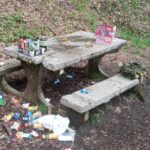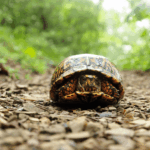What is Trail Magic? What are Trail Angels?
The Appalachian Trail Conservancy (ATC) didn’t invent trail magic, but for over a century, we have managed and cared for the Trail where this concept was born. While people’s interpretation of trail magic varies widely, a few examples may include:
- Finding what you need most when you least expect it.
- Experiencing something rare, extraordinary, or inspiring in nature.
- Encountering unexpected acts of generosity that restore one’s faith in humanity.
Trail magic was born and has flourished on the Appalachian National Scenic Trail (A.T.) within the context of the A.T. experience—the policy that guides Trail managers to preserve the wild, scenic, and natural elements of the Appalachian Trail that allow for the unique feeling of being a part of the natural environment.

Melanie Heurich
Acts of generosity in this wild and primitive setting of the Appalachian Trail—where basic amenities of civilization are intentionally absent—are often received with a heightened sense of wonder and gratitude by hikers. “Trail angel” is a term of endearment given to people who have provided trail magic in the form of direct kindness and generosity to hikers. Volunteer trail maintainers also play an important role in keeping the magic of the Appalachian Trail alive.
Although acts of human generosity are well-intentioned and help to make the A.T. a welcoming place, community members must be careful to support hikers and the Trail in ways that are conducive to the ecological integrity of the A.T., as well as the hiker’s journey.

Samantha Zabawa
Acts of Generosity with Unintended Negative Consequences
Sometimes these acts of generosity (no matter how well-intentioned) may result in additional work for volunteers or may compromise the natural environment. The A.T. was created and is managed to provide people with the opportunity to have a wilderness experience.
Some acts that might be considered “trail magic” can detract from not only the natural sanctuary of the Trail but can also hinder a sense of self-reliance and resourcefulness in hikers—two gifts of the Trail experience. For instance, while long-distance hikers may often appear to be hungry or thirsty, the reality is that the vast majority of them have access to all of the food, drinks, and other supplies they need. Ultimately, a long-distance hike on the A.T. is supposed to be a test of one’s endurance and planning abilities.

Hiker Feeds
Thru-hikers are famous for the ravenous appetites they develop while hiking long miles on rugged terrain. At the same time, those who admire thru-hikers often want to directly support their journeys. As a result, “hiker feeds” have become popular. However, when not planned properly, they can cause overcrowding, unsanitary conditions, and create more work for volunteers.

Negative Impacts of Hiker Feeds
- Crowding. Hiker feeds, especially when advertised in advance, may congregate and merge hikers into an unsustainable ‘bubble’ that moves along the Trail creating new campsites in formerly pristine areas, expanding existing sites, and causing crowding. Large-group dynamics may also create a party atmosphere with alcohol and drugs.
- Health and hygiene. The threat of spreading norovirus and food-borne illnesses is increased by such events which concentrate people in small areas without appropriate facilities
- Increased expectations of special treatment. An abundance of hiker feeds may increase some hikers’ expectations of being entitled to preferential treatment and giveaways. Remember that although long-distance hiking takes grit and determination, it is ultimately a leisure activity. Hikers chose to spend their time toiling on the Trail and can leave whenever they want.
- Hikers may be made to feel like a captive audience. This is especially true if feed facilitators promote their personal worldviews. Hikers should not be made to feel as if they must stop and participate in a feed. Please do not use hiker feeds, or trail magic in general, as an opportunity to proselytize your religious or other personal views.
- Disruption of primitive experience. Holding feeds close to the Trail degrades the primitive, untouched experience for hikers. Such feeds increase litter on Trail and contribute to problems with wildlife becoming habituated to human presence as a potential source of food. This can cause harm to both wildlife and humans, such as when bears lose their fear of humans.
Unattended Food and Drinks
More and more, A.T. managers and volunteers are finding unattended food and drinks left for hikers—coolers at road crossings, sports drinks in streams—while it may be tempting to leave things for hikers, this can create all kinds of problems.

Negative Impacts from Unattended Food and Drinks
- Wildlife may find and eat unattended food and trash. Smells from food, drinks, and trash attract wildlife like bears and raccoons to areas that hikers frequent. Once bears and other animals have received a food reward, they will continue to return to the area searching for more food. This is unsafe for the hikers and for the wildlife. Bears who begin to associate humans with food may become aggressive and have to be relocated or killed.
- Hikers may be tempted to add their own trash. Hikers may falsely believe that the people leaving unattended food will pick up their trash. This trash retains food smells and becomes an easy target for wildlife to consume.
- Unattended food goes bad and attracts insects and rodents. This makes it unsafe for people to eat. If food is left in a bear box, it can spoil and make the bear box unattractive for hikers to use.
- Leaving personal property on public land is illegal. The A.T. is on public land and no one is permitted to leave personal property, no matter how generous the intentions. Unattended items are considered abandoned property and are illegal. Tickets and fines may be issued in some jurisdictions.
- Hikers will expect or rely upon free food. An abundance of unattended food tends to increase expectations of free food available exclusively for thru-hikers. This expectation can lead to improper planning and potentially dangerous situations for hikers.
- The additional work of removing trash and unattended food falls on volunteers. Volunteers work hard to maintain trails and keep the A.T. in top shape. Unattended food and trash pickup is unsanitary and robs time that could be dedicated to other necessary work.
- Unattended food and drinks could be contaminated or tampered with, creating a safety concern. Leaving beer or other alcoholic beverages may allow minors to access it.
How to Better Support Hikers, the Trail, and Local Communities
There are many ways to offer trail magic while supporting hikers, Trail communities, and protecting the Trail we all love.
- Volunteer with an A.T. Trail-Maintaining Club or Trail Crew instead. The existence and health of the A.T. depends on volunteers. The most valuable and essential gift you can give to hikers is to help with Trail maintenance and volunteer recruitment.
- Hike the Trail carrying a bit of extra food, first aid supplies, and water (in sealed containers) to offer to hikers you may encounter on your hike (again, never leave food or drinks unattended). Novice hikers particularly may underestimate the amount of water they will need, or forget to bring it altogether.
- Pack out trash, which accumulates most at trailheads and shelters. Offer to take out hiker’s trash, which helps lighten their packs (trash cans are rarely found along the A.T., and hikers often have to carry an ever-larger bag for days).
- Patronize hiker-friendly businesses in A.T. Communities, especially those that are designated A.T. Community Supporters, to help keep the services they offer available for future hikers.
- Get involved with your local A.T. Community to help the town become more hiker-friendly or work with others in your town to set up a network of drivers to get hikers into and out of town.
- Learn best Leave No Trace practices to help conserve the Trail.
- Donate to a local food pantry in honor of A.T. hikers. Thousands of food-insecure people live along the Trail corridor and have a much greater need than A.T. hikers.

How to Avoid Negative Impacts on the Trail When Providing Food and Drinks to Hikers
Never leave food and drinks unattended. However, if you still choose to provide food and drinks in person to hikers, follow these guidelines to have as little impact as possible on the Trail, Trail experience, and nearby communities. Be aware of the potential impact of your actions. Keep it small and leave no trace.
- Think carefully about the context and broader impacts on the Trail of your planned activities.
- Smaller is better. Keep events small. A.T. regulations require groups to be 25 or fewer, and larger groups require a special use permit.
- Choose off-Trail, developed locations. Some suggestions include state parks that the Trail runs through or public spaces in nearby towns such as churches, community centers, schools, or town squares.
- Chosen areas should be entirely out of sight of the A.T. and in locations that will not be damaged by participants, such as paved or gravel areas.
- Hiker feeds should not be on or block the A.T. Hikers seeking solitude in the wilderness or simply wanting to continue hiking, should not be made to feel obligated to attend a hiker feed.
- Be sure to check with and obtain any required permission from the local land manager such as state park, state or national forest, etc.
- Do not use remote sections of the A.T. or designated wilderness areas to distribute food and drink. Pristine portions of the A.T. or corridor should not be disturbed. Remember that large gatherings in the backcountry can detract from the A.T. experience for some and will lead to the trampling of plants, soil compaction, and disturbance of wildlife habitat.
- Only serve commercially pre-packaged food. If cooked food is provided, it should come from an approved, sanitary kitchen.
- Hand washing facilities should be provided. Norovirus and other food-borne illnesses are a real concern. Hand sanitizer is not effective against norovirus.
- Alcohol should never be served.
- Pack out all trash, food waste, and supplies. All garbage should be collected on-site and disposed of in town at an appropriate site, not carried away by hikers or left for volunteers to clean up. Do not use trailhead trash cans to dispose of trash and food waste from hiker feeds – these often fill up quickly and cannot accommodate the additional trash from a feed.
- Do not collect fees or donations, and do not use feeds as an opportunity to advertise a business. These activities are prohibited on the A.T.
- Do not use hiker feeds, or trail magic in general, as an opportunity to proselytize your religious or other personal views.
- Avoid areas with a high concentration of hiker feeds, particularly Georgia in March and early April, and southwest Virginia in May.
- Consider an alternate time or location further up the Trail when hikers have more of an appetite, or serving those who are often overlooked: southbound hikers, flip-flop thru-hikers, or trail crews.
- Do not publicize a feed. This can lead to unsustainable clumping of hikers. These artificial bubbles of hikers can have significant impacts on pristine areas as they seek space to set up camp after departing a hiker feed. Posting signs on the A.T. is prohibited.
- Choose a location that does not deter hikers from supporting a local business. Small Trailside communities rely on hiker business. Do not set up in a location that could draw business away from a local restaurant or lodging option.
- Before choosing a site, contact experts. Contact the local A.T.-maintaining club or the ATC to find out if there are any special recommendations or considerations. Rare plants, waterways, sensitive cultural sites, or the greater community may be impacted in ways not readily apparent.
- Exercise caution. In today’s society, just like anywhere off the trail, individuals are advised to exercise a measure of caution when offering or accepting hospitality from strangers. Trail angels and hikers should both practice safety awareness.
Caution for Both Hikers and Prospective Trail Angels
The National Park Service Visitor and Resource Protection division has received an increasing number of reports of theft, harassment, and inappropriate behavior as a result of people taking strangers into their private homes and/or vehicles. Kindness and helpfulness may be the predominant culture of the A.T., but people need to realize that not everyone who walks the A.T. or lives nearby is “angelic.” Being too trusting or naive can result in finding yourself in a very dangerous situation.



